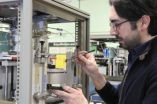(Press-News.org) Scientists have uncovered a lot about the Earth’s greatest extinction event that took place 250 million years ago when rapid climate change wiped out nearly all marine species and a majority of those on land. Now, they have discovered a new culprit likely involved in the annihilation: an influx of mercury into the eco-system.
“No one had ever looked to see if mercury was a potential culprit. This was a time of the greatest volcanic activity in Earth’s history and we know today that the largest source of mercury comes from volcanic eruptions,” says Dr. Steve Grasby, co-author of a paper published this month in the journal Geology. “We estimate that the mercury released then could have been up to 30 times greater than today’s volcanic activity, making the event truly catastrophic.” Grasby is a research scientist at Natural Resources Canada and an adjunct professor at the University of Calgary.
Dr. Benoit Beauchamp, professor of geology at the University of Calgary, says this study is significant because it’s the first time mercury has been linked to the cause of the massive extinction that took place during the end of the Permian.
“Geologists, including myself should be taking notes and taking another look at the other five big extinction events,” says Beauchamp, also a co-author.
During the late Permian, the natural buffering system in the ocean became overloaded with mercury contributing to the loss of 95 per cent of life in the sea.
“Typically, algae acts like a scavenger and buries the mercury in the sediment, mitigating the effect in the oceans,” says lead-author Dr. Hamed Sanei, research scientist at Natural Resources Canada and adjunct professor at the University of Calgary. “But in this case, the load was just so huge that it could not stop the damage.”
About 250 million years ago, a time long before dinosaurs ruled and when all land formed one big continent, themajority of life in the ocean and on land was wiped out. The generally accepted idea is that volcanic eruptions burned though coal beds, releasing CO2 and other deadly toxins. Direct proof of this theory was outlined in a paper that was published by these same authors last January in Nature Geoscience.
The mercury deposition rates could have been significantly higher in the late Permian when compared with today’s human-caused emissions. In some cases, levels of mercury in the late Permian ocean was similar to what is found near highly contaminated ponds near smelters, where the aquatic system is severely damaged, say researchers.
“We are adding to the levels through industrial emissions. This is a warning for us here on Earth today,” adds Beauchamp. Canada has taken a lead role in reducing emissions internationally. In North America, at least, there has been a steady decline through regulations controlling mercury.
No matter what happens, this study shows life’s tenacity. “The story is one of recovery as well. After the system was overloaded and most of life was destroyed, the oceans were still able to self clean and we were able to move on to the next phase of life,” says Sanei.
INFORMATION:
Earth's massive extinction: The story gets worse
New finding on mercury-volcanic link could re-write history on past annihilations
2012-01-09
ELSE PRESS RELEASES FROM THIS DATE:
3-dimensional view of 1-dimensional nanostructures
2012-01-09
Just 100 nanometers in diameter, nanowires are often considered one-dimensional. But researchers at Northwestern University have recently reported that individual gallium nitride nanowires show strong piezoelectricity – a type of charge-generation caused by mechanical stress – in three dimensions.
The findings, led by Horacio Espinosa, James N. and Nancy J. Farley Professor in Manufacturing and Entrepreneurship at the McCormick School of Engineering and Applied Science, were published online Dec. 22 in Nano Letters.
Gallium nitride (GaN) is among the most technologically ...
Another outbreak of coral disease hits the reefs of Kane'ohe Bay, O'ahu
2012-01-09
In March 2010 an outbreak of a disease called acute Montipora White Syndrome (MWS) was discovered affecting coral reefs in Kaneohe Bay, Oahu. Follow-up surveys found that the disease left trails of rubble in its wake. It was estimated that over 100 colonies of rice coral (Montipora capitata) died during that initial outbreak. The disease has reappeared and is killing corals in Kaneohe Bay. The current outbreak has already affected 198 colonies and a rapid response team led by Dr. Greta Aeby (HIMB) has been activated to document the outbreak. Members of the investigative ...
Moderate red wine drinking may help cut women's breast cancer risk, Cedars-Sinai study shows
2012-01-09
LOS ANGELES – Drinking red wine in moderation may reduce one of the risk factors for breast cancer, providing a natural weapon to combat a major cause of death among U.S. women, new research from Cedars-Sinai Medical Center shows.
The study, published online in the Journal of Women's Health, challenges the widely-held belief that all types of alcohol consumption heighten the risk of developing breast cancer. Doctors long have determined that alcohol increases the body's estrogen levels, fostering the growth of cancer cells.
But the Cedars-Sinai study found that ...
A large subgroup of mild-to-moderate asthma is persistently non-eosinophilic
2012-01-09
A large percentage of patients with mild-to-moderate asthma have persistently non-eosinophilic disease which may not respond to currently available anti-inflammatory treatments, according to a new study.
In a cross-sectional study of 995 asthmatic subjects enrolled in nine clinical trials conducted by the NHLBI's Asthma Clinical Research Network, sputum eosinophilia (≥2% eosinophils) was
found in only 36% of asthmatics not using an inhaled corticosteroid (ICS) and 17% of those using an ICS. Among patients who achieved good asthma control, 26% had sputum eosinophilia, ...
Statins may increase risk of interstitial lung abnormalities in smokers
2012-01-09
Use of statins may influence susceptibility to or the progression of interstitial lung disease (ILD) in smokers, according to a new study.
While some studies have suggested that statins might be beneficial in the treatment of fibrotic lung disease, others have suggested that they may contribute to the progression of pulmonary fibrosis by enhancing secretion of inflammasome-regulated cytokines, and numerous case reports have suggested that statins may contribute to the development of various types of ILD.
"Based on earlier case reports of statin-associated ILD and data ...
Study shows no evidence of a mortality benefit to PSA screening
2012-01-09
Men enrolled in the Prostate, Lung, Colorectal and Ovarian Cancer (PLCO) Screening Trial had no evidence of a mortality benefit compared to a control group of men undergoing usual care, according to a study published online Jan. 6 in the Journal of the National Cancer Institute.
The Prostate, Lung, Colorectal and Ovarian Cancer Screening (PLCO) Trial is a multi-center, two-arm trial, which began enrollment in November 1993 with follow-up through December 2009, and was designed to evaluate the effect of screening on these specific cancers. The enrollees were aged 55-74 ...
A new wild ginger discovered from the evergreen forest of Western Ghats of South India
2012-01-09
Intensive botanical explorations for taxonomic studies on the members of the ginger family (Zingiberaceae) in India by V.P. Thomas and M. Sabu of the University of Calicut, have resulted in the discovery of an interesting species of Amomum (Cardamom) from Silent Valley National Park on the Western Ghats of Kerala.
The ginger family consists of 53 genera and over 1,200 species, many of which are widely used as spices, for medical purposes, or simply for decoration. Amomum Roxb. is the second largest genus within the Zingiberaceae, comprising about 150-180 species, including ...
Study finds age-related effects in MS may be reversible
2012-01-09
BOSTON (MA) -- Scientists at Joslin Diabetes Center, Harvard University, and the University of Cambridge have found that the age-related impairment of the body's ability to replace protective myelin sheaths, which normally surround nerve fibers and allow them to send signals properly, may be reversible, offering new hope that therapeutic strategies aimed at restoring efficient regeneration can be effective in the central nervous system throughout life.
In a proof-of-principle study published in the journal Cell Stem Cell, the researchers report that defects in the regeneration ...
Hopes for reversing age-associated effects in MS patients
2012-01-09
New research highlights the possibility of reversing ageing in the central nervous system for multiple sclerosis (MS) patients. The study is published today, 06 January, in the journal Cell Stem Cell.
As we get older, our bodies' ability to regenerate decreases. This is not only true for our skin (which is evident in the wrinkles that develop as we age) but also true for other tissues in the body, including the regenerative processes in the brain. For diseases which often span several decades and are affected by regenerative processes, such as multiple sclerosis, this ...
How poor maternal diet can increase risk of diabetes -- new mechanism discovered
2012-01-09
Researchers funded by the Biotechnology and Biological Sciences Research Council have shown one way in which poor nutrition in the womb can put a person at greater risk of developing type 2 diabetes and other age-related diseases in later life. This finding could lead to new ways of identifying people who are at a higher risk of developing these diseases and might open up targets for treatment.
The team, from the University of Cambridge and the Medical Research Council (MRC) Toxicology Unit at the University of Leicester, publish their findings today (Friday 6 January) ...
LAST 30 PRESS RELEASES:
Air pollution exposure and birth weight
Obstructive sleep apnea risk and mental health conditions among older adults
How talking slows eye movements behind the wheel
The Ceramic Society of Japan’s Oxoate Ceramics Research Association launches new international book project
Heart-brain connection: international study reveals the role of the vagus nerve in keeping the heart young
Researchers identify Rb1 as a predictive biomarker for a new therapeutic strategy in some breast cancers
Survey reveals ethical gaps slowing AI adoption in pediatric surgery
Stimulant ADHD medications work differently than thought
AI overestimates how smart people are, according to HSE economists
HSE researchers create genome-wide map of quadruplexes
Scientists boost cell "powerhouses" to burn more calories
Automatic label checking: The missing step in making reliable medical AI
Low daily alcohol intake linked to 50% heightened mouth cancer risk in India
American Meteorological Society announces Rick Spinrad as 2026 President-Elect
Biomass-based carbon capture spotlighted in newly released global climate webinar recording
Illuminating invisible nano pollutants: advanced bioimaging tracks the full journey of emerging nanoscale contaminants in living systems
How does age affect recovery from spinal cord injury?
Novel AI tool offers prognosis for patients with head and neck cancer
Fathers’ microplastic exposure tied to their children’s metabolic problems
Research validates laboratory model for studying high-grade serous ovarian cancer
SIR 2026 delivers transformative breakthroughs in minimally invasive medicine to improve patient care
Stem Cell Reports most downloaded papers of 2025 highlight the breadth and impact of stem cell research
Oxford-led study estimates NHS spends around 3% of its primary and secondary care budget on the health impacts of heat and cold in England
A researcher’s long quest leads to a smart composite breakthrough
Urban wild bees act as “microbial sensors” of city health.
New study finds where you live affects recovery after a hip fracture
Forecasting the impact of fully automated vehicle adoption on US road traffic injuries
Alcohol-related hospitalizations from 2016 to 2022
Semaglutide and hospitalizations in patients with obesity and established cardiovascular disease
Researchers ‘listen in’ to embryo-mother interactions during implantation using a culture system replicating the womb lining
[Press-News.org] Earth's massive extinction: The story gets worseNew finding on mercury-volcanic link could re-write history on past annihilations



